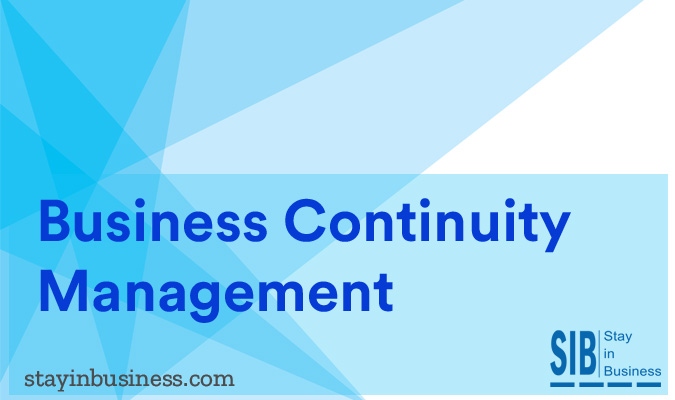
Enterprises that invest massively in their businesses need to make sure that they remain safe and secured even at times facing the most unfavorable conditions and be resilient in continuing business. To maintain this resiliency companies should follow certain Business Continuity Management (BCM) principles. This concept of Business Continuity Management introduced by, “Stay In Business” facilitates your organization in identifying business threats even before they transpire and provides you with a best solution in first place. It helps to improve security by providing you the information to be cognizant of the risks your business may be vulnerable to, from both outside and within the business while keeping you on the beam. Stay In Business has been helping out many entities with its proven Business Continuity and Disaster Recovery Plans as well, while getting them well prepared to face any kind of disaster.
Regardless of incident’s size and the reason behind it, any business might get highly affected. Business Continuity Management is all about identifying those areas of the business that an enterprise can’t think of loosing critical things like important data, employees, stock and premises. BCM will analyze the threats and suggest appropriate precautions including plans on how to be resilient at such times.
Businesses may be small, medium or large sized but the definition of “loss” is not going to differ. So, regardless of their entity’s size, every business should follow the framework of Business Continuity Management policy which will safeguard its key stakeholders along with its reputation.
BCM includes disaster and business recovery along with crisis management, incident and emergency management and contingency planning. This is accomplished by the introduction of well thought resilience strategies in order to reduce the probability and overall impact of a threat. An enterprise that plans even before the incident takes place will come back into its business in a shortest possible time compared to un-planned one.
For organizations that are un-planned might take much longer than the planned ones to continue their business or probably might not show up in the market any more. These delays mean an immense loss for entities irrespective of their sizes. Not only an entity but also its key suppliers and business partners maintaining a proper BCM plan in place will act as a safeguard to that entity by lessening the impact of any incident.
Simply put, the elements of Stay In Business’s BCM program ensures an enterprise rebound.
General Reasons for BCM failure:
- Missing commitment
- Non-existence of BCM experience and knowledge
- Lack of ownership
- Lack of confidence
Our BCM program includes….
1. Program Inception and its Management:
Initial step would be to apprehend the need for a Business Continuity Management within the entity. Later on develop the program by completely analyzing the business risks and vulnerabilities. Resilient strategies are introduced to make the business viable along with recovery plans, to get back on its feet at the quickest possible time. The motive of this program is to get support from the entity in building the organizational framework in order to develop the BCM program.
2. Risk Evaluation and Measures to Control:
Both innate and obtained threats along with the vulnerabilities that are detrimental to the company are identified. Once those threats are identified, the assessment of their probability along with hidden level of impact becomes facile. Enterprises can now focus on high probability and high impact events to realize at which point the controls and management processes are futile. This evaluation helps the entity in increasing its resiliency through additional controls requested by BCM program.
3. Business Impact Analysis (BIA):
Basing on the Risk Evaluation process, enterprises recognize both likely and potential impacts including the touchstone used to quantify and qualify those impacts. The Recovery Time Objective (RTO) and Recovery Point Objective (RPO) are defined for each of the entity’s processes through the measurement and assessment of financial, consumer and reputation impacts. This Business Impact Analysis helps in identification of time sensitive processes and gets entity’s avail requirements to recover them in the time frame that is acceptable to it.
4. Business Continuity Strategies:
The collective data of Risk Evaluation and Business Impact Analysis is used in identifying available continuity and recovery strategies. This will enable the entity to continue with its operations and technology. These strategies must meet both the recovery time and recovery point objective to get approved and funded by the entity. On the recommended strategies a cost benefit analysis is performed in such a way that the cost of implementing the strategy against the assets at risk is fine-tuned.
5. Emergency Response and Operations:
Entity has a plan, in order to respond to the emergency situations that may impact safety of its employees, visitors or other assets. The requirements to develop and implement this plan are defined by Emergency Response and Operations practice. In case of emergency, the response plan assists the companies in handling that situation very tactically while ensuring the safety of employees until the trained team arrives.
6. Plan Implementation and Documentation:
The business continuity plan is nothing but a set of documented processes and procedures that are implemented in order to enable the entity to continue its business or recover the time sensitive processes. This recovery is done within the timeframe to be passable to the entity.
7. Awareness and Training Programs:
Entity’s staff should be trained on how to respond during an emergency. For achieving this goal, company needs a program that brings awareness regarding Business Continuity Management in the staff. Basing on this ideology an awareness and training program is developed and implemented at times of disaster.
8. Cooperation from External Agencies:
A set of policies and procedures are established in order to coordinate with external agencies at different levels following the law that helps in both business continuity and quick recovery.
By adopting this Stay In Business’s BCM program, entities will always be prepared to thump in disasters face.
Luminous Benefits of the Business Continuity Management program:
- Prepares an entity to be resilient at all the times.
- Legal and statutory obligations are met by BCM.
- Reduces the risk of financial loss to an entity.
- Helps in suppressing the effect of a disruption on an entity.
- Enable the recovery of critical systems in an acceptable timeframe.
- Leaves the staff in safe hands.
- Minimizes the probability of life threat.
- Wins back the confidence of employees to that organization.
- Ensures the clients and suppliers that particular entity is still in market.
- Makes sure that company repossesses its fame
BCM’s ultimate goal will be providing the organization with the ability to withstand an incident and spring back as well.
Twelve Mistakes of Business Continuity Management to be avoided:
- Ignoring Continuity policies and Standards.
- Leadership and teamwork ignored by Recovery plans.
- Resiliency is usually ignored by many.
- Recovery scenarios are mostly limited to Disaster.
- Proceeding without gathering enough details.
- Forgetting the Public.
- Lack of focus on execution.
- Recovery plans are not early tested.
- Crisis management is excluded by IT DR.
- Ignoring time constraints.
- Critical systems are not well managed to get back into action.
- Ignoring statute while developing BCM.




